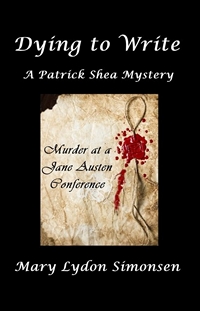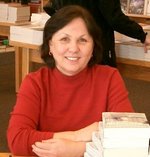 My loyal readers who have followed Austenprose for years know that in addition to Austenesque fiction, I love a good who-dun-it. There are some fabulous Regency-era mysteries featuring Jane Austen and her characters as sleuths including Stephanie Barron’s Being a Jane Austen Mystery Series (12 novels) and the Mr. & Mrs. Darcy Mysteries by Carrie Bebris (6 novel and one in the oven). Besides the Elizabeth Parker Mysteries (4 novels) by Tracy Kiely there are very few contemporary mysteries inspired by Austen, so when one hits my radar I am a very happy Janeite.
My loyal readers who have followed Austenprose for years know that in addition to Austenesque fiction, I love a good who-dun-it. There are some fabulous Regency-era mysteries featuring Jane Austen and her characters as sleuths including Stephanie Barron’s Being a Jane Austen Mystery Series (12 novels) and the Mr. & Mrs. Darcy Mysteries by Carrie Bebris (6 novel and one in the oven). Besides the Elizabeth Parker Mysteries (4 novels) by Tracy Kiely there are very few contemporary mysteries inspired by Austen, so when one hits my radar I am a very happy Janeite.
Mary Lydon Simonsen, author of several fabulous Austenesque historical novels including: Searching for Pemberley, A Wife for Mr. Darcy and Becoming Elizabeth Darcy, also writes a detective series called The Patrick Shea Mysteries. In her latest installment, Dying to Write, she has cleverly blended both Austen-inspired and a contemporary mystery. Today, Mary has kindly offered an excerpt for our enjoyment.
BOOK DESCRIPTION
In need of a break from his job at Scotland Yard, Detective Sergeant Patrick Shea of London’s Metropolitan Police, is looking forward to some quiet time at a timeshare in rural Devon in England’s West Country. However, when he arrives at The Woodlands, Patrick finds himself in the midst of a Jane Austen conference. Despite Regency-era dresses, bonnets, and parasols, a deep divide exists between the Jane Austen fan-fiction community, those who enjoy expanding on the author’s work by writing re-imaginings of her stories, and the Janeites, those devotees who think anyone who tampers with the original novels is committing a sacrilege. When one of the conference speakers is found dead in her condo, Patrick is back on the job trying to find out who murdered her. Is it possible that the victim was actually killed because of a book?
EXCLUSIVE EXCERPT
(Setting: First day of the Jane Austen seminar – Detective Patrick Shea sits down with a group of Jane Austen purists.)
“I understand the kickoff for the Austen game starts this afternoon,” Patrick said after introducing himself.
“Right after lunch,” a woman, wearing a nametag that identified her as Michelle Johnson of Sidmouth, answered and then giggled. “We are all very excited.”
“I can tell,” he said, looking around the room. “You can feel it in the air.”
Actually, Patrick could smell it. To a copper, the smell of trouble was as strong as the coffee being served with the scrambled eggs. It was as if West Side Story had come to Colyton. There were the Jets, the guardians of Jane Austen’s writings and the status quo, versus the Sharks, writers and readers of Jane Austen re-imaginings who wanted to add their own twist to her stories, each huddling in their respective corners.
The previous night, after finding nothing on the telly, Patrick had opened his laptop and Googled “Jane Austen.” Ten million suggested sites came up. Eventually, he stumbled upon the JAFF community and a link to a website where people wrote stories inspired by Austen’s characters. The way it worked was that after reading a post, people were allowed to comment on the story. Although most responses were supportive of the writer’s efforts, a few had been written by disapproving readers who did not like where the author had taken Austen’s stories and weren’t shy about saying so.
“What’s the afternoon session about?”
“Jane Austen in Bath,” Cassandra Woolton of Exeter answered. “Although her years in Bath were not the happiest for our dear Jane, I do think her later work was inspired by her time there, especially when she wrote of Fanny Price’s isolation in Mansfield Park and Anne Elliot’s loss of purpose after Captain Wentworth’s departure in Persuasion.”
“Are you leading the session, Mrs. Woolton?”
“Miss Woolton, although I have no objection to the honorific, and, ‘yes,’ I am leading the session. With my late father, I co-authored several monographs on Jane Austen, her work, and her final resting place in Winchester Cathedral.”
“And tomorrow?”
“Jane Austen’s Juvenilia.” Patrick had no idea what that meant, but he decided not to let on. Keep them guessing.
“Do you read any of the variations, retellings, or whatever you call them?” Patrick asked.
“Facts or opinions which are to pass through the hands of so many, to be misconceived by folly in one and ignorance in another, can hardly have much truth left,” Miss Woolton answered.
“I take that to be a ‘no.’”
“Those words are from the pen of the author herself—Persuasion published in 1818.”
Patrick was about to push off when Miss Woolton indicated that Althea Duguid, the lecturer for tomorrow’s session, was about to join them. Having heard about the previous year’s row between Duguid and another speaker, he decided to hang around.
Patrick gestured for Mrs. Duguid to take his seat. As soon as she had, Duguid asked Millicent Fenwick of Sherborne, a little mouse of a woman, to prepare a plate for her and held up “her stick” as a reason for the request.
Turning to Patrick, she asked, “And you are…?”
“Patrick Shea. I’m down from London for a few days.”
“Will you be attending the sessions?”
“No. That’s not why I came to Devon. A friend lent me his week for a timeshare. It’s a coincidence that it’s the same week as the Jane Austen conference.”
“In my opinion, you would be foolish to pass up an opportunity to learn more about one of the most brilliant authors in the English language.”
“To each his own,” he answered. “I prefer mysteries to romance.”
“Jane Austen did not write romances,” Duguid said with a tone of dismissal. “She wrote about family, neighbourhoods, and social connections.”
“You had better keep that to yourself, or you’ll have everyone tearing off their I ♥ Darcy car stickers.”
Duguid grimaced at the thought of someone reducing Austen’s protagonist to a punch line appearing on the fender of a car.
“Having been a teacher for forty years, I can state unequivocally that there is a reason why schools establish curricula. How else would the masses be introduced to the writings of great authors? If left to their own devices, their preference would be to stick their noses in such things as mystery novels, forgotten as soon as they are finished.”
“Not sure I agree with that, and I don’t think Agatha Christie or Conan Doyle would either,” Patrick said, laughing at the dig at his choice of reading material. “In my opinion, people should not be forced to read books that don’t appeal to them just because someone else has decided it’s good for them. Reading is supposed to be pleasurable.”
“Mr. Shea, your statement smacks of criticism. Can you possibly be referring to the schism between the Janeites and the JAFF community?”
“What I’m saying is that there’s no reason to get into a snit over reading material.”
“The Rubicon has been crossed. That is a reference to—”
“I know about Julius Caesar crossing the Rubicon, Mrs. Duguid. But your statement sounds very much like someone who is looking for a fight.”
“I shall not back down. There are some things worth fighting for.”
“My list of what’s worth fighting for does not include what book is on someone’s night table.” This discussion was accomplishing nothing, and with storms moving in, Patrick needed to get going. “Your breakfast is getting cold,” he said, pointing to her plate. “I hope you have a lovely day, and despite differences of opinion, you all get along.”
“I do have one question for you, Mr. Shea. Are you going to have this conversation with Miss Ball when she arrives? She is the authoress of those Pemberley monstrosities.”
“I can do that.”
Chapter 5
Thank you Mary for sharing this excerpt with us today. The characters look intriguing. I can see that you have stirred up the different factions of Jane Austen fans and created a great storyline from it. I look forward to reading it. Best wishes.
AUTHOR BIO
 Mary Simonsen first became acquainted with Jane Austen when she was a senior in high school in the late 1960s in North Jersey. Little did she know that thirty-five years later her first novel, Searching for Pemberley, would be published by Sourcebooks followed by three traditional P&P re-imaginings. Since that time, she has written and self-published numerous Austen re-imaginings, including two time-travel romances: Becoming Elizabeth Darcy and Another Place in Time. Lately, she has branched out into mystery novels. Dying to Write, a British police procedural involving Jane Austen fans, is the fourth in the Patrick Shea mystery series.
Mary Simonsen first became acquainted with Jane Austen when she was a senior in high school in the late 1960s in North Jersey. Little did she know that thirty-five years later her first novel, Searching for Pemberley, would be published by Sourcebooks followed by three traditional P&P re-imaginings. Since that time, she has written and self-published numerous Austen re-imaginings, including two time-travel romances: Becoming Elizabeth Darcy and Another Place in Time. Lately, she has branched out into mystery novels. Dying to Write, a British police procedural involving Jane Austen fans, is the fourth in the Patrick Shea mystery series.
Mary lives in the Valley of the Sun (aka Phoenix), but when the temperatures hit triple digits, she and her husband head up to Flagstaff in Arizona’s High Country, a perfect place to write a novel.
Blog Facebook Twitter Goodreads
Dying to Write: A Patrick Shea Mystery, by Mary Lydon Simonson
Quail Creek Publishing, LLC (2014)
eBook (257) pages
ASIN: B00KD3L56W
Cover image courtesy of Quail Creek Publishing © 2014; excerpt Mary Lydon Simonsen © 2014, Austenprose.com
Thank you, Laurel Ann, for featuring my book on your blog.
LikeLiked by 1 person
You are most welcome Mary. It is always a pleasure.
LikeLike
Mary, I love that you put a contemporary murder mystery in the setting of a Jane Austen conference! That sounds like the best of both worlds and the makings of a fabulous book! Can’t wait to read it. Don’t enter me in the giveaway, Laurel Ann, as I already have the book. All I need is time to read it! Enjoyed the post, ladies!
LikeLiked by 1 person
No giveaway Janet so no worries.
LikeLike
Great excerpt, Mary! Mrs. Duguid is a real spitfire. I always get a kick out of reading feisty old women!
LikeLiked by 1 person
Sorry, Laurel Ann. I forgot to mention please do not enter me in the giveaway. :)
LikeLike
Thanks for visiting Jakki. No giveaway being offered. Just Mary’s fabulous excerpt!
LikeLike
I love that scene. It’s so funny how each side feels so possessive of Jane and Patrick is just so confused by them.
LikeLiked by 1 person